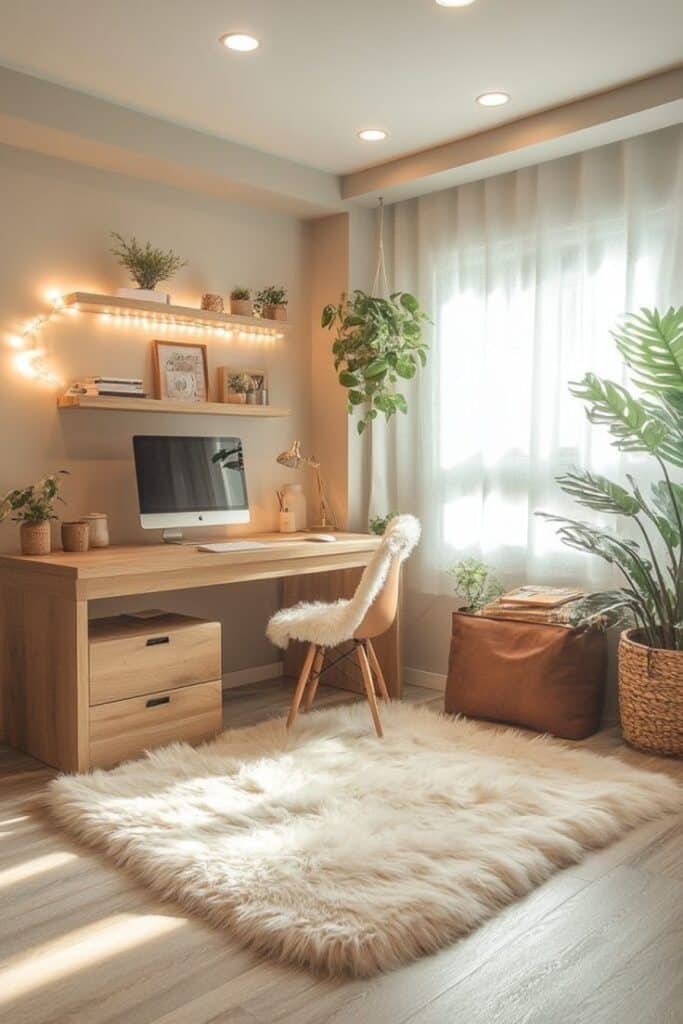Creating your desired Home Office
There’s a difference between simply having a desk at home and creating a space where you actually enjoy working: your home office. Maybe you’re working remotely, freelancing, running a business, or just need a dedicated area for studying, journaling, or personal projects. Whatever the reason, your workspace matters. It affects your focus, creativity, and even your mood.
A cluttered, uncomfortable space can make even the simplest tasks feel like a chore, while a well-thought-out setup can help you settle in and get things done with ease. The good news? You don’t need a massive budget or a separate home office to create a workspace that works for you. It’s all about making intentional choices: choosing the right spot, setting up in a way that minimises distractions, and making sure it feels both functional and inviting.
Let’s talk about how you can transform your work-from-home setup into a space that inspires you, keeps you comfortable, and makes productivity feel natural instead of forced.
1. Find Your Perfect Spot (Trivia: It’s Probably Not Your Bed)
The first step? Choosing the right place to set up. If you’re lucky enough to have a separate home office, great! But if not, no worries, you can still carve out a workspace in a corner of your bedroom, living room, or even by a window. The key is to find a spot that helps you switch into work mode. Sitting in the same place where you sleep or binge-watch TV? That’s a recipe for distractions, and before you know it, work and relaxation will blur into one unproductive mess.
If space is tight, get creative. A foldable desk, a floating shelf, or even a designated section of your dining table can work. The trick is to create some form of separation between work and rest, even if it’s just a mental boundary. This can be as simple as using a small rug under your desk to define the area, adding a partition, or positioning your chair to face away from distractions. If you’re sharing your space with family or roommates, communicate your work hours and set boundaries to minimise interruptions.
2. Invest in a Comfortable Chair (Your back will thank you)
I know you can make do with a lot of things, but a bad chair isn’t one of them. You might think you can tough it out sitting on your couch, perching on a stool, or using that plastic dining chair, but trust me, your back will have a different opinion after a few hours.
If you’re going to spend long stretches at your desk, do yourself a favour and invest in a chair that supports your posture. No, you don’t need to drop a fortune on a top-tier ergonomic chair (though if you can, it’s worth it), but at the very least, look for one with good back support, an adjustable height, and a comfortable seat cushion. A chair that encourages proper spinal alignment will keep you from slouching or hunching over your desk, which can lead to aches, stiffness, and long-term posture problems.
If an ergonomic chair isn’t in the budget right now, there are still ways to make your seating situation more comfortable. A lumbar support pillow, or even a rolled-up towel placed at the small of your back, can help maintain a natural curve in your spine. A cushioned seat pad can reduce pressure on your hips and tailbone, making long work sessions more bearable. Even the way you position your feet matters—keeping them flat on the floor or on a footrest can prevent strain on your lower back.
Also, don’t underestimate the importance of movement. Even with the best chair, sitting for too long isn’t great for your body. Stand up, stretch, and move around every hour to keep your circulation flowing. Your back (and the rest of your body) will thank you in the long run.
3. Good Lighting = Better mood & productivity
A quiet corner with good lighting (preferably natural light) can work wonders. Studies show that exposure to natural light improves mood and focus, so if you can, set up near a window. But if that’s not possible, warm, soft artificial lighting can help mimic the effect. Avoid overly dim or harsh fluorescent lights that strain your eyes and make your space feel sterile.
Harsh lighting can make your workspace feel cold and uninspiring, while poor lighting strains your eyes. The sweet spot? Soft, natural light during the day and warm, ambient lighting in the evening. If you don’t have a well-lit space, consider adding a simple desk lamp with warm-toned bulbs. Bonus points if it’s dimmable, so you can adjust the brightness as needed.
4. Personalize Your Space (Because you’re not in a bland cubicle)
One of the best things about working from home? You’re not stuck in a dull office with bland grey walls and fluorescent lights. Take advantage of that! Start by adding things that make you happy and inspired—after all, you’re going to be spending a lot of time here. A framed quote that motivates you, a vision board filled with your dreams and goals, or even a piece of artwork that speaks to you can turn your desk into a space that fuels creativity and focus.
If you love greenery, consider adding a plant (or several). A little touch of nature can make a huge difference, not just aesthetically but also for your mood. A snake plant or pothos is low-maintenance and great for improving air quality, while a small succulent plant requires minimal effort and still brings a fresh vibe to your office space. Even if you don’t have a green thumb, a high-quality fake plant can create the same effect without the commitment.
Scent can also influence productivity and mood. If certain scents help you focus or relax, consider adding a candle, an essential oil diffuser, or even a simple room spray. Lavender can be calming, citrus scents can be energising, and peppermint is great for mental clarity. Just keep it subtle—too much fragrance can become distracting.
The little things truly matter. Whether it’s a soft throw blanket over your chair, a fun mug for your coffee, or a playlist that sets the mood for deep work, these small touches make your home workspace a place where you actually enjoy spending time. The goal isn’t just functionality—it’s about creating an environment that feels good to be in. Your workspace should feel like you, not just another corporate setting.

5. Keep Clutter Under Control (But don’t aim for perfection)
A messy workspace can make your mind feel cluttered too. But then, you don’t have to turn into a minimalist overnight. The goal is to have functional organisation. A few trays or baskets to keep things tidy, a cable organiser to prevent the dreaded wire chaos, and maybe a small shelf or pegboard to store essentials. A clear workspace equals a clearer mind.
That said, don’t stress about keeping everything perfect. A little bit of organised chaos is fine as long as it doesn’t slow you down.
6. Create a Work Vibe (Sound matters too!)
Silence can be distracting. If you find it hard to focus in complete quiet, consider playing soft instrumental music or nature sounds. If you need to block out household noise, a white noise machine or noise-cancelling headphones can be game changers.
Some people work best with upbeat music, while others prefer lo-fi beats or even coffee shop background noise. Experiment and find what works for you.
7. Make It Easy to Switch Off (Because work-life balance exists)
When your office is literally in your home, it’s easy for work to bleed into personal time. One way to prevent this? Have a shutdown ritual. Maybe it’s closing your laptop, turning off your desk lamp, or even playing a specific song when you’re done for the day. Small cues like this help signal to your brain that work is over.
Also, if you can, avoid keeping your work setup in your bedroom. But if that’s your only option, try covering your work area at the end of the day—maybe with a cloth, a screen divider, or just by putting your laptop away. It helps create a mental boundary between “work mode” and “home mode.”
At the end of the day, the best work-from-home setup is the one that works for you. It doesn’t have to be Instagram-perfect or match someone else’s aesthetic. It just needs to be a space that makes you feel comfortable, focused, and inspired.
So, optimise what you have at the moment. Be it a full-fledged home office or a small desk in the corner of your living room, make it a place where you actually want to sit down and create magic. And hey, if you are not ready for all the asthetic thingy, just make sure you have a comfortable chair, good lighting, and a mug of your favourite drink nearby. That’s half the battle won. 😉
What’s your favourite way to make your home workspace feel cosy and inspiring? Let’s chat in the comments!
For more ideas on how to put together your home office, check out this post on Architectural Digest
Stay frosty.




